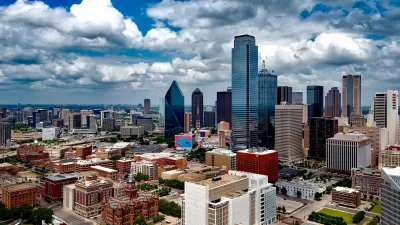As new studies show the fundamental connection between trees and human health, cities are recognizing the essential elements in cultivating thriving urban canopies. And they're enacting policies to ensure their protection and growth.
As Lindsay Abrams noted recently in The Atlantic, our ability to quantify the ways in which trees improve our physical and mental health - by providing oxygen, cleaning our air of pollutants, and in more nuanced ways - is steadily increasing. Despite this recognition, writes Leda Marritz, "The USDA Forest Service recently determined that U.S. cities are losing around 4 million trees annually — this at a time when average urban canopy cover in North America is still lower in most places than what is recommended by American Forests."
Why is it that cities continue to struggle to protect and grow their tree canopies? According to Marritz, creative director of DeepRoot Green Infrastructure and an ISA-certified arborist, at least part of the problem lies in the challenge of providing the right type and volume of soil to support tree growth. She points to examples from Toronto, Denver, Emeryville, and West Virginia, of ambitious policies that require street trees to receive a certain minimum amount of soil in order to support healthy urban forests.
"None of these policies is perfect," says Marritz. "There are tweaks, of varying sizes, that I would make to all of them. Still, they represent a critically important step to creating lasting, healthy, thriving urban canopy cover in cities."
"It takes more than a soil volume minimum to cultivate a thriving, mature urban canopy. Good tree stock, soil quality, adequate water and regular maintenance cannot be undervalued. But we’ll continue to lose canopy cover at an alarming rate if we don’t change the way we plant trees in cities," she concludes. "We know what this means, and we simply need to do it. It starts with soil."
FULL STORY: Saving the Urban Canopy

Alabama: Trump Terminates Settlements for Black Communities Harmed By Raw Sewage
Trump deemed the landmark civil rights agreement “illegal DEI and environmental justice policy.”

Planetizen Federal Action Tracker
A weekly monitor of how Trump’s orders and actions are impacting planners and planning in America.

Why Should We Subsidize Public Transportation?
Many public transit agencies face financial stress due to rising costs, declining fare revenue, and declining subsidies. Transit advocates must provide a strong business case for increasing public transit funding.

Understanding Road Diets
An explainer from Momentum highlights the advantages of reducing vehicle lanes in favor of more bike, transit, and pedestrian infrastructure.

New California Law Regulates Warehouse Pollution
A new law tightens building and emissions regulations for large distribution warehouses to mitigate air pollution and traffic in surrounding communities.

Phoenix Announces Opening Date for Light Rail Extension
The South Central extension will connect South Phoenix to downtown and other major hubs starting on June 7.
Urban Design for Planners 1: Software Tools
This six-course series explores essential urban design concepts using open source software and equips planners with the tools they need to participate fully in the urban design process.
Planning for Universal Design
Learn the tools for implementing Universal Design in planning regulations.
Caltrans
Smith Gee Studio
Institute for Housing and Urban Development Studies (IHS)
City of Grandview
Harvard GSD Executive Education
Toledo-Lucas County Plan Commissions
Salt Lake City
NYU Wagner Graduate School of Public Service




























